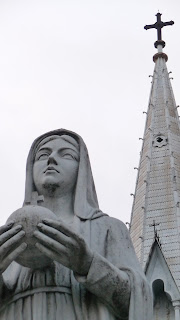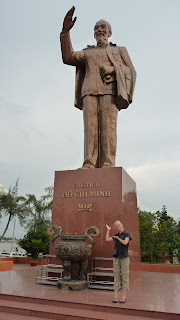Imagine a
strong, fast and big bike. Imagine the sun on your face and the wind in your
hair. Imagine winding mountain roads through lush jungle. Imagine total
freedom.
 |
| Jens is alone on the bike |
 |
| Anna on the bike with Trung Pagoda |
What you
have just conjured up in your mind are only a couple of the great things you
experience when taking a motorbike trip with the legendary Easy Rider Bikers
from Dalat. So of course, after we took a single day tour around Dalat with
them, we wanted more. Nothing easier than that with the Easy Riders: changed
all our plans regarding time, budget and places to see in Vietnam and booked a
5 day tour from Dalat to Hoi An. It was the trip of a lifetime! We went through
the central highland of Vietnam and got to see not only breathtaking scenery
but also the everyday life of the rural Viet people and their history.
 |
| View from the Ho Chi Minh trail into the central highland |
Farming
 |
| Visiting a coffee plantation (arabica) |
 |
| Caoutchouc being harvested at a rubber tree farm |
Vietnam’s
soil is great for all sorts of farming and it makes Vietnam a leading exporting
country for many agricultural products. Dalat is the flower city of Vietnam because
of its dry, cool climate. From the top of the mountains you see whole valleys
covered with growhouses. The surrounding area, the south of the central
highlands, seems to be one huge coffee plantation. The coffee is harvested right
now and all the streets, the roofs and everything else that offers some space
are covered with the precious beans that dry in the sun before being shipped to
the roasting plants. A little further north it's spices: you can go for miles
through pepper plantations or drive by thousands of curry trees. And slowly the
landscape changes and suddenly you are surrounded by massive forests of rubber
trees, all being planted in neat rows. These huge plantations are dotted by big fields of pineapples, local fruits like the
forest strawberry, sugar cane fields and tapioca tree forests, paper trees,
bananas in the jungle and so on and so forth. Farming is the strong backbone of
the central highland's economy.
History
 |
| War memorial in Buon Ma Thout |
The central
highland set the scene for some of the fiercest fighting between Vietnamese and
American soldiers and got devastated by American chemical weapons. The
remaining scars can be found in the landscape, where formerly jungle-topped
mountains are only covered by gras, and they become obvious when talking to the
older generation of local people. Many suffer from the influence of Agent
Orange or still mourn their family members, some are still regarded as heroes for
having killed a certain number of enemies and whole villages get money from the
governmet because they are classified as heroic villages for
their strength during the wartime. Travelling along the famous Ho Chi Minh
Trail that was used to supply the south with soldiers and weapons from the
north you see war remnants on every corner. Burnt out ruins of French churches,
old American airports in the middle of the bush, war memorials in every city
and names like “Bloodlake” or “Hamburger Hill” (for the meat that topped the
hill after an especially hard fight) on the maps. The war might be over and the
young generation is far from being too worried about it – but this country will
surely never forget.
Working
 |
| Children working in a brick factory on weekends |
We visited
many small local factories, often in the back of peoples’ houses. Most of them
don’t have a good education and not enough money for land to farm on, so they
make their money with simple things and hard work. From the skillful work at a
traditional silk factory to the basic steps that are necessary to produce rice
wine, from the hard work that even children do at the brick factories to the
innovative minifarming of mushrooms, from the making of incense-sticks to the
art of fine woodcarving - these and many
more are the ways the Viet people make money, support their families or
villages and survive.
Religion
 |
| Wooden church in Kon Tum |
Even though
many more catholic churches than buddhist pagodas can be found in the central
highlands, we learned a lot about the buddhist philosophy and the art of
meditation. We met a master monk at the most important Zen center in Vietnam
and he told us about ways to let go of your thoughts (tried and failed), we
went to see temples with different Buddhas and found out that we like the fat,
laughing Buddha the most as he gives happiness to all people, regardless of
their belief or if they are good or bad and we talked a lot about the
background stories of Buddhism. Always keep in mind: what goes around, comes
around!
 |
| Orphanage belonging to the catholic church |
Ethnic
minorities
 |
| Village of the M'nong Ga near Dalat |
 |
| Communal building (Nha Rong) of Bahnar hill tribe |
The central
highlands are home to many different hill tribes that have always lived in and
of the mountain jungles. Today they still speak their own languages,
follow their traditions and live by their own rules. Most are very poor, many
don’t use money at all but only trading. The communist
government would like the minorities (54 in all of Vietnam) to adopt the modern
lifestyle of the Vietnamese and only speak the common language, but they
resist. They tend to only marry one another, stay in their small groups and
they usually don’t leave their homeland. It has been a great pleasure to meet some
of them (like the Bahnar, the M’nong or the K’ho) in their villages and learn a
little bit about their lives. The way they have to hunt for their food or pick
what grows in the forests, how they build their houses and tools and the way
their families and tribes are socially built up – all these things were really
fascinating to hear about. Yet, as romantic as the selfsufficient, easy life might sound, you must not forget how poor
these people are, that they have no sanitary installations and no medicine
other than their herbs. Life may be mostly happy for them – but definitely also
very hard.
Food
 |
| Pit stop for some fried sweet potato and banana |
 |
| Enjoying local specialities |
Travelling with two Vietnamese, we tried out so much food and local specialties that their has to be a small section about the food as well (especially since they made fun of me as being the one that has to stop at every street stall to try out
every little new thing). In Dalat we tried the persimmon fruit that only grows
in that area and is being harvested in the moment. It looks like a tomato when
it is ripe and tastes fantastic, very sweet and soft. Other fruits that we
tried were the durian, a very smelly huge spiky fruit that has a weird texture
and might be the only fruit in the world I have to puke from, the tamarinde
fruit, a very sour root-shaped fruit that we dipped into spicy garlic sauce,
and the forest strawberry that is a wild fruit from the jungle and has nothing
to do with strawberries as we know them (looks and texture are more like a litchi’s). We tried sugar cane juice which is so refreshing and tasty,
and drank the most expensive coffee in the world, the weasel coffee. We had
great treats like boiled peanuts, sticky rice with sweet beans and banana,
ricepowder-cake with green beans and sweet potatoe-fritters with ginger. The
main dishes we had included several variations of self rolled fresh springrolls
where you get all the ingredients, put them into dry ricepaper and then
roll them like a fajita (but way better!), great BBQ-chicken with garlic fried
rice, stir fried morning glory and cabbage with garlic, shared platters with
all sorts of beef, fish and seafood, soups and veggies and a great final dinner
of wild jungle deer mixed with jungle herbs. All in all a greatt culinary
experience!
After 1+5
wonderful days of easy ridin’ we were dropped off safe and sound in Hoi An, one
of the former capitals of Vietnam.













































